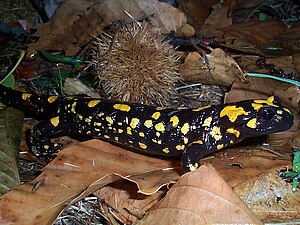Corsican fire salamander
| Corsican fire salamander | ||||||||||||
|---|---|---|---|---|---|---|---|---|---|---|---|---|

Corsican fire salamander ( Salamandra corsica ) |
||||||||||||
| Systematics | ||||||||||||
|
||||||||||||
| Scientific name | ||||||||||||
| Salamandra corsica | ||||||||||||
| Savi , 1838 |
The Corsican fire salamander ( Salamandra corsica ) is a species of amphibian from the family of real salamanders . The endemic only on the island of Corsica occurring salamander was first described in 1838 by the Italian naturalist Gaetano Savi (1769-1844). Until a few years ago, the Corsican fire salamander was still regarded as a subspecies of the European fire salamander Salamandra salamandra and referred to as Salamandra salamandra corsica . With regard to the development and distribution of the herpetofauna in the Tyrrhenian Islands, the question arises why this species only exists in Corsica.
features
Adult females reach considerable body lengths of up to 22 centimeters. The predominantly black upper side is interrupted by irregularly distributed yellow spots, which occasionally can be almost circular. Overall, Corsican fire salamanders look more stocky than their Central European relatives. The animals' extremities also appear shorter and the toes stronger - a clear indication of the increased digging lifestyle. Observations show that the animals retreat to deeper soil layers during longer periods of drought. The broad head with strongly developed parotids is striking . The yellow spots on the eyelids and ear glands sometimes show S-shaped line structures.
habitat
Corsican fire salamanders prefer to live in the rainy mountain forests of the island. On the west coast there are only a few occurrences above sea level (" Calanche de Piana" between Porto and Piana ), as a rule, Corsican fire salamanders are more likely to be found in higher habitats. But even in the leeward location at Tavignano in Corte immediately below the citadel, Corsican fire salamanders come to about 430 m above sea level. NN before. In the vast slopes and ravines forests of downy and sessile oak is found mainly siedlungsnah many neat chestnuts - Selven that represent a typical salamander habitat. Forests with overly dense undergrowth such as bracken and tree heather ( Erica arborea ) are not avoided, but are less densely populated. Hollow oak forests at a lower level are hardly populated; here the precipitation conditions and the microclimate are often too unfavorable. Beech forests are more likely to be inhabited by the Corsican fire salamander in the eastern part of the island ( e.g. Castagniccia ), as the beech on the island in the windward- facing areas forms the upper end of the mountain forest. Outside of the summer months, the conditions here are often almost subalpine, which the Corsican fire salamander tends to avoid.
The middle layers of Corsica have a typical mountain climate, which is characterized by relatively low temperatures and frequent rainfall. The meltwater that comes from the high mountains also provides cool, clean spring water into the summer months, which accumulates in numerous pools and creates ideal larval habitats for the Corsican fire salamander. In the vicinity of small streams, in particular, there are often shaded block heaps that offer salamanders good day hiding places.
Reproductive strategies
In the Restonica valley , the herpetologist Robert Mertens found at about 1000 m above sea level. NN a pregnant female who gave birth to four young animals without gills. They also had a distinctive body color, so that they almost resembled the adult salamander. However, Mertens also found keel-bearing, exclusively aquatic fire salamander larvae with the inconspicuous larval color in nearby waters . Such viviparity is known from a north-west Spanish subspecies of the fire salamander ( Salamandra salamandra bernardezi ) and the alpine salamander ( Salamandra atra ) and can be understood as an adaptation to xerothermic climate and the associated water poverty.
Danger
Due to the low population density of Corsica, large parts of the impassable hillside forests have so far been only slightly influenced by humans, so that the Salamandra corsica populations living there can still be classified as safe. The amphibians are occasionally threatened by artificial fish stocks in the upper reaches of streams and rivers as well as by forestry measures such as the construction of forest and hiking trails. Locally, water pollution and soil erosion caused by domestic animals in the wild ( pigs , goats ) can affect the salamanders' habitats.
Synonyms
- Salamandra moncherina (Bonaparte, 1839)
- Salamandra maculosa var.corsica Bedriaga, 1883
- Salamandra moncheriana Schreiber, 1912
- Salamandra salamandra corsica Nikolsky, 1918
literature
- Michel Delaugerre, Marc Cheylan: Atlas de Repartition des Batraciens et Reptiles de Corse . Parc Naturel Regional de Corse / Ecole Pratique des Hautes Etudes, L'Oikéma Pamplona (Spain), o. O. 1992, ISBN 2-905468-09-2 .
- Robert Mertens : The amphibians and reptiles of Corsica. - Senckenberg. Biol. 38 (1957, issue 3/4): 175-192, Frankfurt / M.
- Miaud, C. 2004 Salamandra corsica . 2006 IUCN Red List of Threatened Species. Downloaded on July 9, 2007.
- Thomas Mutz: Salamandra corsica (Savi, 1838) - Corsican fire salamander. - In: Burkhard Thiesmeier & Kurt Grossenbacher (Hrsg.): Handbuch der Reptilien und Amphibien Europa, Schwanzlurche IIB. Aula Verlag, 2004, pp. 1029-1046.
- Willy Wolterstorff : Forays through Corsica. Faber'sche Buchdruckerei, Magdeburg 1901, 35 pp.
Web links
- Photos of the Corsican Fire Salamander on www.herp.it
- Global Amphibian Assessment: Salamandra corsica (Engl .; among others with a large distribution map)
- Salamandra corsica inthe IUCN 2013 Red List of Endangered Species . Posted by: Claude Miaud, Marc Cheylan, Roberto Sindaco, Antonio Romano, 2008. Retrieved November 20, 2013.
